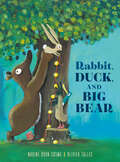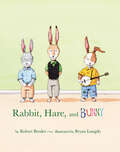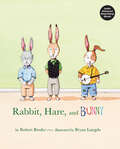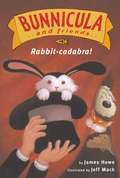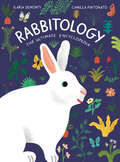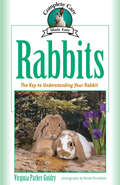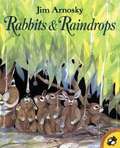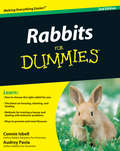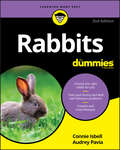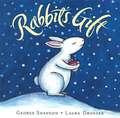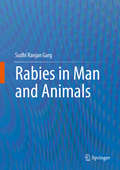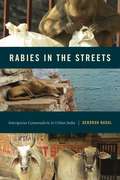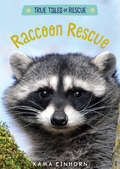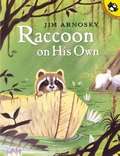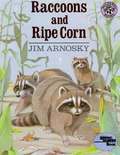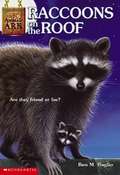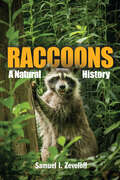- Table View
- List View
Rabbit's Surprise (Fountas & Pinnell Classroom, Guided Reading)
by Mike Spoor Kate SpringerNIMAC-sourced textbook. Poor Mole! Mole is sad. Rabbit wants to cheer his friend up. But how?
Rabbit, Duck, and Big Bear
by Nadine Brun-CosmeA picture book about three best friends who do everything together, until they each realize that sometimes having time alone can be nice too.Rabbit, Duck, and Big Bear are best friends. They do everything together and go everywhere together except for one place. They never go down the long and winding path together. But this winter, when Rabbit, Duck, and Big Bear go skating on the frozen pond, Rabbit loses control and barrels straight down the path. What she finds there is one of the most beautiful places she has ever seen, but to her surprise, Big Bear and Duck both admit they sometimes go there when they want to be alone. And while she sits in the quiet calm, Rabbit begins to understand why. In this story rich with social emotional learning, young readers will see the importance of balancing time with friends and time spent on their own. Nadine Brun-Cosme and Olivier Tallec perfectly pair to create a fun story with lovable characters and an important message. This book is the ideal read-aloud to help little ones wind down before quiet time.
Rabbit, Hare, and Bunny
by Robert BroderRabbit, Hare, and Bunny are roommates. But sometimes roommates don't get along.Rabbit and Hare finally have enough of Bunny's eccentric behavior and ask him to move out. But they soon realize a good roommate is hard to find. And when Bunny moves back in with his parents, Bunny realizes being more aware of how his actions affect others might not be the worst thing he could do.
Rabbit, Hare, and Bunny
by Robert Broder*Audio Enhanced Read-Along EbookRabbit, Hare, and Bunny are roommates. But sometimes roommates don' t get along.Rabbit and Hare finally have enough of Bunny' s eccentric behavior and ask him to move out. But they soon realize a good roommate is hard to find. And when Bunny moves back in with his parents, Bunny realizes being more aware of how his actions affect others might not be the worst thing he could do.
Rabbit-Cadabra! (Bunnicula and Friends #4)
by James HoweWhen Chester learns that the Amazing Karlovsky will use a rabbit in his school magic show, he comes up with a plan to stop vampire bunnies.
Rabbitology: The Ultimate Encyclopedia
by Ilaria DemontiDiscover all there is to know about rabbits in Rabbitology, a delightfully illustrated and educational guide to these charming and gentle animals.Welcome to the wonderful world of rabbits. Rabbitology is filled with incredible information about this lovable animal species, relayed in a playful tone by author Ilaria Demonti, with adorable illustrations by Camilla Pintonato.Did you know rabbits can be found on every continent except Antarctica? Or that they dig burrows with tunnels over one hundred feet long? Have you ever wondered why rabbits eat their own poop? Or why their teeth never stop growing?These and other intriguing and engaging facts about the lovable bunny can be found in Rabbitology, a visual encyclopedia and follow-up to Chickenology, Pigology, and Sheepology in the Farm Animal series of books. Nature- and animal-loving readers of all ages will find something to learn and love about these fascinating creatures. Perfect for gift-giving to curious kids, and anyone who enjoys charming animal facts books.Praise for the Farm Animal series"Pigology, Chickenology, and Sheepology are my absolute favorite books about farm animals. They explain history and science with ease and charm. These books help us to see that reality transcends fiction, and that once we understand it, our sense of wonder deepens, making the world more enjoyable and more magical."– Isabella Rossellini
Rabbits
by Virginia Parker Guidry Renee StockdaleA Complete Care Made Easy guide to the irresistible rabbit-that big-eared super pet that is "cuddly, quiet, full of personality, affordable...really cute and really soft," in the inspired words of author Virginia Parker Guidry. Illustrated with the beautiful photography of Reneé Stockdale, Rabbits begins with a fun chapter on the history beginning with the European wild rabbit, the only species ever to be domesticated, which led to all of our modern-day breeds and varieties of pet rabbit. This guide offers practical advice on choosing the right rabbit for a newby to rabbits, addressing responsibilities, costs, and available breeds as well as sex, size, and personality types. The author gives the reader much to consider, especially when one considers there are 45 different breeds of beautiful bunnies recognized by the American Rabbit Breeders Association. The acquisition of a healthy rabbit from a breeder, shelter, or pet shop is discussed in the chapter "Adopting a Rabbit," and the future keeper's home preparations are encapsulated in "Preparing for a Rabbit," wherein the author discusses indoor and outdoor housing and safety, family introductions, healthful food options, and rabbit supplies. As with all editions in the Complete Care Made Easy series, Rabbits offers the full range of care required to keep a pet happy and healthy, and the chapter "The Best of Care" includes feeding guidelines, grooming tips, handling, training, cleanliness, and travel advice. The health of the rabbit is of paramount concern to the keeper, and the author's text covers preventive care, veterinary selection, vaccinations, spaying/neutering, dealing typical rabbit health problems, old-age care, and first aid. For keepers who want to understand their rabbits more fully, "Think Like a Rabbit" is a fascinating look into rabbit behavior, language, and potential behavioral issues (such as chewing, biting, and scratching). The expression "breeding like rabbits" is based in pure biology, and rabbit enthusiasts who wish build up their warrens will be interested in reading "The Facts of Life," a primer on rabbit reproduction. The title of the final chapter of the book, "Just for Fun" says it all: here's a rundown of the many ways rabbit owners can enjoy their bunnies-rabbit shows, 4-H events, games at home, and getting involved with clubs (listed in the resources section of the book). Glossary and index included.
Rabbits And Raindrops
by Jim ArnoskyIt's the first day outside the nest for Mother rabbit's five babies, and all sorts of new creatures and adventures await them. But when a sudden rain shower sends the rabbits scurrying for shelter under the hedge, the other wild animals come to visit them! Jim Arnosky's graceful watercolors and simple text are sure to delight children experiencing nature's wonders for the first time.
Rabbits For Dummies
by Audrey Pavia Connie IsbellYour hands-on guide to being a responsible rabbit owner Want to raise a happy, healthy bunny? This practical guide gives you everything you need to know to successfully adopt, nurture, live with, and love a rabbit. From choosing a rabbit and preparing its home to training, healthcare, and having fun with your bunny, you get a wealth of expert tips that will have your rabbit (and you) hopping with joy! Jump into bunny basics - decide whether a rabbit is the right pet for you, discover the different breeds, and find out the best places to adopt your bunny Take care of creature comforts - from housing and grooming to feeding and healthcare, provide the best care for your friend Practice bunny "psychology" - understand bunny body language and sounds, handle behavior issues, and train your bunny to do tricks and use the litter box Enjoy the wonderful world of rabbits - play games with your bunny, join clubs and organizations, show your rabbit, and make traveling with bunny easy Open the book and find: Informative photos and illustrations Detailed breed descriptions How to think like a rabbit Tips for handling bad bunny behavior The latest on organic cuisine and homegrown feeding options Games to play with your rabbit How to live with an indoor bunny (which is recommended!) Ten signs that require emergency action A bunch of bunny resources - from rescue groups to registries to Web sites
Rabbits For Dummies
by Audrey Pavia Connie IsbellChoose the right rabbit for you Train your bunny and deal with behavior problems Prevent and treat illnesses Your guide to being a responsible rabbit owner Want to raise a happy, healthy bunny? This practical guide gives you everything you need to know to successfully adopt, nurture, live with, and love a rabbit. Find detailed breed descriptions, information on organic cuisine, helpful top ten lists, and more. You can even teach your bunny to perform tricks! From choosing a rabbit and preparing its home to training, healthcare, and having fun with your furry friend, discover a wealth of expert tips that will have your rabbit (and you) hopping with joy. Inside... The latest on housing, cleaning, and feeding How to think like a rabbit Games to play with your bunny How to live with an indoor rabbit A bunch of bunny resources Ten signs that require emergency action
Rabbits Gift
by George ShannonSnow is coming, coming soon, so Rabbit needs to find food fast. Just in time, a turnip turns up, and a second one, too. Who in the woods wouldn't want to tuck away an extra turnip for the long winter? Not Rabbit. He chooses a different path--and starts a wave of generosity that spreads among all his forest friends. Admired picture-book team George Shannon and Laura Dronzek have created a heartwarming tale about the true meaning of friendship. Includes an author's note and a chart that translates the Chinese calligraphy in the book.
Rabies in Man and Animals
by Sudhi Ranjan GargRabies is the deadliest zoonotic disease that threatens humans and animals on all continents except Antarctica. Asia and Africa are worst affected as more than 95 per cent of rabies associated human deaths occur in these regions. India alone bears about 36 per cent of the global human rabies burden. Dogs are the main transmitters of rabies that potentially threaten over 3 billion people in Asia and Africa. Many developed nations have been able to successfully control dog rabies but continue to face the risk from wildlife including bats. Bat rabies is responsible for most human rabies deaths in the United States of America and Canada but has emerged as a public health threat in Australia, Latin America and Western Europe as well. Despite being vaccine preventable, rabies continues to haunt the mankind. Poor resources is a major constraint but the factors like low priority attributed to rabies, misconceptions in the community about the disease and unsystematic approach for its prevention and control are also responsible for the grim situation. Targets have been set for elimination of human and dog rabies in all Latin American countries by 2015 and of human rabies transmitted by dogs in South-East Asia by 2020. However, the myths prevailing among the people together with inadequate knowledge of the health professionals, veterinarians, and the civic body staff about the rabies prevention and control strategies might make the task very difficult. This book comprising eight chapters elaborates the causation of rabies in man and animals, its global epidemiology, risk analysis and effective strategies for the management of exposures. Proven methods of rabies prevention and control have been discussed in length along with the challenges and ways to overcome the constraints through intersectoral coordination. The inclusion of 200 frequently asked questions is a unique feature of the book which may help not only the common people and pet lovers in clearing their doubts about rabies in man and animals also be equally instrumental in updating the knowledge and skills of the public health personnel, veterinarians and other professionals. Apt illustrations and simple language make the contents of the book easily comprehensible and a reading pleasure.
Rabies in the Streets: Interspecies Camaraderie in Urban India (Animalibus #16)
by Deborah NadalFound in two-thirds of the world, rabies is a devastating infectious disease with a 99.9 percent case-fatality rate and no cure once clinical signs appear. Rabies in the Streets tells the compelling story of the relationship between people, street animals, and rabies in India, where one-third of human rabies deaths occur. Deborah Nadal argues that only a One Health approach of “interspecies camaraderie” can save people and animals from the horrors of rabies and almost certain death.Grounded in multispecies ethnography, this book leads the reader through the streets and slums of Delhi and Jaipur, where people and animals, such as dogs, cows, and macaques, interact intimately and sometimes violently. Nadal explores the intricate web of factors that bring humans and animals into contact with one another within these urban spaces and create favorable pathways for the transmission of the rabies virus across species. This book shows how rabies is endemic in India for reasons that are as much social, cultural, and political as they are biological, ranging from inadequate sanitation to religious customs, from vaccine shortages to reliance on traditional medicine.The continuous emergence (and reemergence) of infectious diseases despite technical medical progress is a growing concern of our times and clearly questions the way we think of animal and environmental health. This original account of rabies challenges conventional approaches of separation and extermination, arguing instead that a One Health approach is our best chance at fostering mutual survival in a world increasingly overpopulated by humans, animals, and deadly pathogens.
Rabies in the Streets: Interspecies Camaraderie in Urban India (Animalibus: Of Animals and Cultures #16)
by Deborah NadalFound in two-thirds of the world, rabies is a devastating infectious disease with a 99.9 percent case-fatality rate and no cure once clinical signs appear. Rabies in the Streets tells the compelling story of the relationship between people, street animals, and rabies in India, where one-third of human rabies deaths occur. Deborah Nadal makes the case that only a One Health approach of "interspecies camaraderie" can save people and animals from the horrors of rabies and almost certain death.Grounded in multispecies ethnography, this book leads the reader through the streets and slums of Delhi and Jaipur, where people and animals, such as dogs, cows, and macaques, interact intimately and sometimes violently. Nadal explores the intricate web of factors that bring humans and animals into contact with one another within these urban spaces and create favorable pathways for the transmission of the rabies virus across species. This book shows how rabies is endemic in India for reasons that are as much social, cultural, and political as they are biological, ranging from inadequate sanitation to religious customs, from vaccine shortages to reliance on traditional medicine.The continuous emergence (and reemergence) of infectious diseases despite technical medical progress is a growing concern of our times and clearly questions the way we think of animal and environmental health. This original account of rabies challenges conventional approaches of separation and extermination, arguing instead that a One Health approach is our best chance at fostering mutual survival in a world increasingly overpopulated by humans, animals, and deadly pathogens.
Raccoon Rescue (True Tales of Rescue)
by Kama EinhornWhat is life like for a group of orphaned raccoon siblings, born in the attic of a home, as they experience life at a raccoon rehabilitation center in California? This photo‑packed series explores the stories and science behind animal sanctuaries, including all of the ups and downs that go along with caring for wild raccoons away from their natural element. Includes full‑color photos, graphics, and maps. At WildCare in San Rafael, California, many wild animals are brought in every day – skunks, birds, opossums, squirrels, and more – including raccoons. Four baby raccoons are put into the hands of WildCare staff, specifically volunteer Shelley. The kits need feedings, medicine, burpings, and even help going to the bathroom. The kits are not allowed to spend any time with other humans – they can’t be used to humans once they are returned to the wilds of suburbia. A steady process involving enrichment, exercise, outdoor exposure– and more than you’ll ever think you’ll know about raccoons and other city wildlife – fills the pages of Raccoon Rescue.
Raccoon on His Own
by Jim ArnoskyWhen a baby raccoon is swept downstream in an abandoned canoe, he feels afraid. But soon he notices all kinds of things he has never seen before, and from the safety of his little boat, he begins to explore the world around him. Paralleling the exciting-and often frightening-experience of a child's first adventure away from home, Raccoon on His Own offers little ones a glimpse of being on their own for the very first time.
Raccoons (Nature's Children)
by Laima DingwallDescribes the physical features, natural environment and habits of raccoons, the masked bandit.
Raccoons and Their Relatives (World Book's Animals of the World)
by Pat Harvey SullivanDo raccoons wear masks? What's special about a raccoon's "hands"? Do raccoons wash their food? Do raccoons hibernate in winter? Find out all about the physical characteristics, habits, and behavior of raccoons and such related species as the coati, kinkajou, red panda, and ringtail.
Raccoons on the Roof (Animal Ark #21)
by Ben M. BaglioMandy's delighted when she spots a mother and baby raccoon on the roof of the house where she's staying. But the next door neighbor doesn't like the raccoons, and has laid traps for the playful creatures and wants them destroyed.
Raccoons: A Natural History
by Samuel I. ZeveloffThe word raccoon is drawn from the Native American Algonquian language. Their term arakun roughly translates to "he who scratches with his hands." Anyone who has found a raccoon rummaging around in a once securely closed trash container can attest to how skillful raccoons are with their front paws. In fact, they have four times as many sensory receptors in their forepaw skin as they do in their hindpaws, a ratio similar to that of human hands and feet. Samuel Zeveloff explores this trait and much more in his accessible natural history of raccoons.Written with the general reader in mind, Raccoons presents detailed information on raccoon evolution, physical characteristics, social behavior, habitats, food habits, reproduction, and conservation, as well as their relationship with humans and many other topics. The section on distribution and subspecies focuses on the raccoon's current range expansion, and the material on their cultural significance demonstrates this mammal's unique status in different North American cultures.
Raccoons: Raccoon Magic For Kids
by Jeff FairRelates the author's childhood story about an orphan raccoon that came to live with him and presents information about this intelligent, masked creature.
Race Across Alaska: First Woman to Win the Iditarod Tells Her Story
by Libby Riddles Tim JonesLibby Riddles wanted an adventure. At age 16 she left home for the snowy wilderness of Alaska, the Last Frontier. There her love of animals drew her to the sport of sled dog racing. When she entered the Iditarod, the famous marathon from Anchorage to Nome, she was just another Iditarod Nobody. Twelve hundred miles later, having conquered blizzards, extreme cold, and exhaustion, she and her dogs crossed the final stretch of sea ice, miles ahead of the nearest competitor... and suddenly she realized: I will be the first woman to win the Iditarod. This is the story of a courageous woman and her heroic dogs. This is the story of Libby Riddles's adventure.
Race Horse Men
by Katherine C. MooneyRace Horse Men recaptures the vivid sights, sensations, and illusions of nineteenth-century thoroughbred racing, America's first mass spectator sport. Inviting readers into the pageantry of the racetrack, Katherine C. Mooney conveys the sport's inherent drama while also revealing the significant intersections between horse racing and another quintessential institution of the antebellum South: slavery. A popular pastime across American society, horse racing was most closely identified with an elite class of southern owners who bred horses and bet large sums of money on these spirited animals. The central characters in this story are not privileged whites, however, but the black jockeys, grooms, and horse trainers who sometimes called themselves race horse men and who made the racetrack run. Mooney describes a world of patriarchal privilege and social prestige where blacks as well as whites could achieve status and recognition and where favored slaves endured an unusual form of bondage. For wealthy white men, the racetrack illustrated their cherished visions of a harmonious, modern society based on human slavery. After emancipation, a number of black horsemen went on to become sports celebrities, their success a potential threat to white supremacy and a source of pride for African Americans. The rise of Jim Crow in the early twentieth century drove many horsemen from their jobs, with devastating consequences for them and their families. Mooney illuminates the role these too-often-forgotten men played in Americans' continuing struggle to define the meaning of freedom.
Race to Callan Castle/The Best Engines Ever! (Thomas & Friends)
by Random HouseIt's all about speed and racing in this new Thomas & Friends 2-books-in-1 ebook! Train-obsessed boys and girls ages 3 to 7 can read the first story and then flip the book over for another exciting tale about Thomas and his engine friends.

